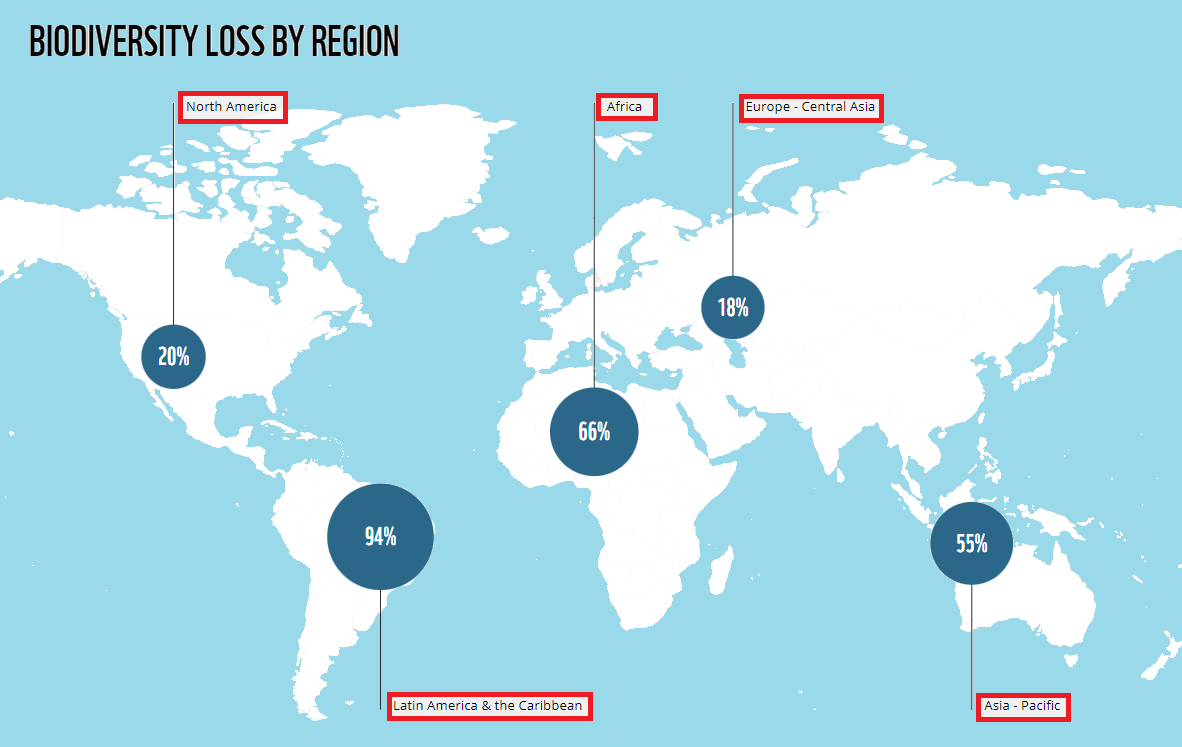Biodiversity & Environment
Living Planet Report 2022
- 14 Oct 2022
- 4 min read
For Prelims: Living Planet Report 2022, WWF, Living Planet Index (LPI), Mangroves, Sunderbans, Migration, Climate Change, Biodiversity.
For Mains: Biodiversity Loss, Related Threats.
Why in News?
There has been a 69% decline in the wildlife populations of mammals, birds, amphibians, reptiles and fish, across the globe in the last 50 years, according to the Living Planet Report 2022 by World Wide Fund for Nature (WWF).
- This report is released every two years.
What are the Key Findings of the Report?
- Region-wise Decline in Wildlife Populations:
- The highest decline in the wildlife populations (94%) was in the Latin America and the Caribbean region.
- Africa recorded a 66% fall in its wildlife populations from 1970-2018 whereas the Asia-Pacific recorded a decline of 55%.
- Decline in Freshwater Species:
- Freshwater Species populations globally reduced by 83%.
- Habitat loss and barriers to migration routes were responsible for about half of the threats to monitored migratory fish species.
- Freshwater Species populations globally reduced by 83%.
- Collapsing Vertebrate Wildlife Populations:
- Living Planet Index (LPI) showed that vertebrate wildlife populations are collapsing at a particularly staggering rate in tropical regions of the world.
- Featuring about 32,000 populations of 5,230 species across the world, LPI is a measure of the state of the world's biological diversity based on population trends of vertebrate species from terrestrial, freshwater and marine habitats.
- Living Planet Index (LPI) showed that vertebrate wildlife populations are collapsing at a particularly staggering rate in tropical regions of the world.
- Mangrove Degradation:
- Mangroves continue to be lost to aquaculture, agriculture and coastal development at a rate of 0.13% per year.
- Many mangroves are also degraded by overexploitation and pollution, alongside natural stressors such as storms and coastal erosion.
- Around 137 square kilometres of the Sundarbans mangrove forest in India and Bangladesh has been eroded since 1985, reducing land and ecosystem services for many of the 10 million people who live there.
- Mangroves continue to be lost to aquaculture, agriculture and coastal development at a rate of 0.13% per year.
- Key Threats to Biodiversity:
- WWF identified six key threats to biodiversity to highlight ‘threat hotspots' for terrestrial vertebrates:
- Agriculture
- Hunting
- Logging
- Pollution
- Invasive Species
- Climate Change
- WWF identified six key threats to biodiversity to highlight ‘threat hotspots' for terrestrial vertebrates:
What is World Wildlife Fund for Nature?
- It is the world’s leading conservation organization and works in more than 100 countries.
- It was established in 1961 and is headquartered at Gland, Switzerland.
- Its mission is to conserve nature and reduce the most pressing threats to the diversity of life on Earth.
- WWF collaborates at every level with people around the world to develop and deliver innovative solutions that protect communities, wildlife, and the places in which they live.
What are the Recommendations of the Report?
- The planet is experiencing double emergencies of human-induced climate change and biodiversity loss, threatening the well-being of current and future generations. Biodiversity loss and climate crisis should be dealt with as one instead of two different issues as they are intertwined.
- A nature-positive future needs transformative, game-changing shifts in how we produce, how we consume, how we govern and what we finance.
- An all-inclusive collective approach towards a more sustainable path must be adopted. It will ensure that the costs and benefits from our actions are socially just and equitably shared.





